
Chapel Stained Glass
Since its dedication in 1992, the Chapel of St. Timothy and St. Titus has served as the site of thousands of daily services and numerous special events. It was intentionally constructed in the center of campus — reflecting the Seminary community’s emphasis on worship as a central activity of its life and being.
Thanks to a generous gift from the Eugene E. and Nell S. Fincke Memorial Trust, established by the sainted Finckes, stained glass windows have been installed throughout the entirety of the chapel — chancel, transept, nave and narthex. The Te Deum Laudamus (We Praise You, O God), a historic text of praise to God, is the thematic touchpoint and framework for the windows, which depict the humiliation, crucifixion, resurrection, exaltation and second coming of Christ.
The Finckes were generous supporters of the Seminary. In addition to setting aside funds specifically for the installation of new stained glass windows in the chapel, the couple also provided gifts that established endowed professorships and scholarships for students.
When the chapel was designed, it was built with the capacity for stained glass throughout the building, but the funding was not available at the time. As such, the only stained glass windows originally installed were located in the chancel. The original chancel windows, depicting St. Timothy and St. Titus, were part of the 1992 dedication of the chapel but were removed in 2019 to make way for the new windows to be installed. The Finckes’ earmarked gift fulfills the original plans for the chapel.
The new stained glass windows offer a more complete display of Christ throughout the entirety of the chapel, culminating in the chancel window as our resurrected Savior takes central place in the worship space above the altar.
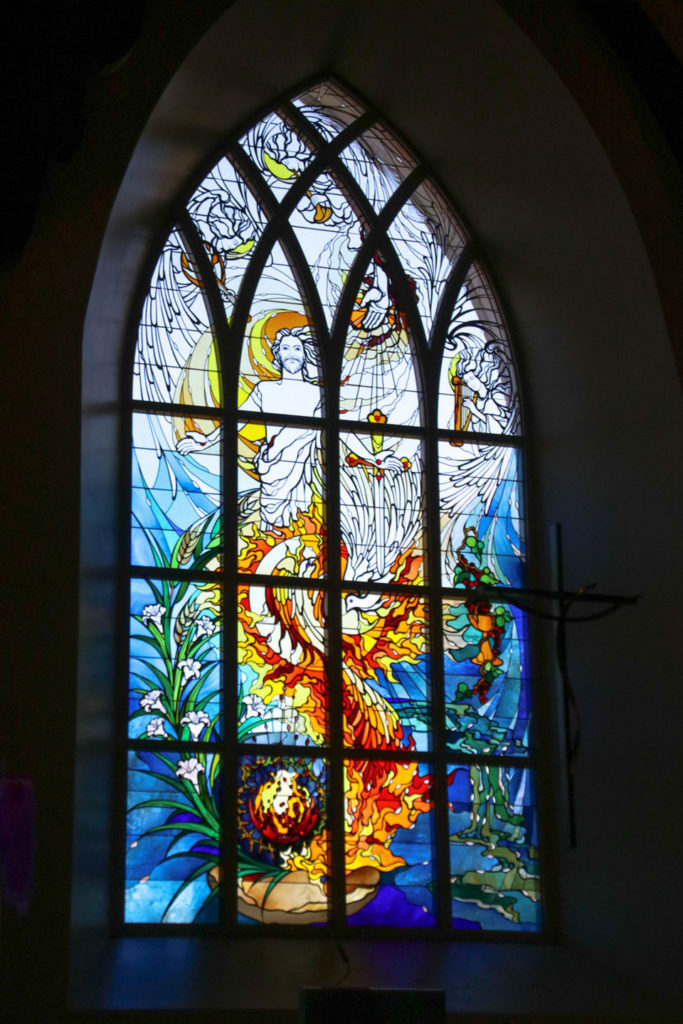
Work begins
A stained glass design committee worked for two years in preparation for the new stained glass windows. The committee was composed of nine members: President Emeritus Dr. Dale A. Meyer, the Louis A. Fincke and Anna B. Shine Professor of Systematic Theology and former Dean of Chapel Dr. Kent Burreson, Chairman of the Practical Theology Department Dr. David Schmitt, former Dean of Theological Research and Publication Dr. Erik Herrmann, Seminary Executive Vice President and Chief Operating Officer Michael Louis, Dean of Chapel Emeritus Dr. James Brauer, Dovetail Creations Artist Rev. Bill Matzat, Director of Campus Facilities Martin Hague and C&W Services Site Director Ray Allen.
The Te Deum and its glorification of God by the church and all creation permeates all the windows and propels the thematic development including the central story of Christ. As a written piece, the Te Deum is rich in theology. It fills the hearts and minds of worshipers with images and figures from Scripture that lead to joyous eternal praise of God. The light, color and design of the stained glass windows invite worshipers into several activities: the joyous praise of the Triune God by the created world and human creatures; the remembrance of Christ’s saving work that draws everyone to the Father as Christ rules over all creation until His return on Judgment Day; and the purpose of the Seminary — to prepare pastors, deaconesses and other church workers, who with Word and Sacrament, carry the Good News of Jesus Christ wherever they are sent.
The committee presented the results of their careful study and received approval from the Seminary’s Board of Regents to proceed with the project. The installation of the windows began in 2020 and was completed in 2022.
New theme, same mission
Lynchburg Stained Glass of Lynchburg, Va., with senior artist Rich Buswell in charge of the design, was selected to create and install the new windows. The faceted stained glass window in the chancel of the Chapel of St. Timothy and St. Titus was removed in October 2019 to make way for the new windows that are fabricated of leaded glass, which has a longer life span than faceted glass. The original chancel window had reached the halfway point of its life span; the new leaded glass windows will last ostensibly forever, barring some catastrophe, and the leading and framing are expected to endure at least 100 years. A specialty of Lynchburg Stained Glass is the artistic use of clear and stained glass to allow natural light also to shine, reflecting God’s creation, which permeates the space from outside through the windows into the chapel. The intentional use of clear glass at the top of the chancel window maximizes natural light flowing into the chapel.
The resurrected Christ is the subject of the central window, just as He is and remains the center of our worship and praise. The original chancel window, featuring Sts. Timothy and Titus, will be repurposed elsewhere on campus although the exact location has not yet been determined.
The new windows adorn the worship space thematically in two primary areas: the nave, and the chancel/transepts. In the nave, the windows celebrate the Te Deum’s opening emphasis on the praise of God by all creation in heaven and on earth.
The chancel/transept windows, functioning as a type of triptych, lead worshipers into the latter part of the Te Deum’s emphasis on the ministry and work of Christ, tracing His life, death, resurrection and enthronement until His return to judge the living and the dead. At the center of that triptych is the theme of the resurrection and reign of Christ, represented in the chancel window. The worship space thus moves clockwise from the praise of all creation to the praise of God’s people specifically for God’s saving work, the mystery made known most fully to us in the life, death and resurrection of Jesus Christ.
The past, present and future reality of preparing pastors, deaconesses, missionaries and other church leaders is interwoven as a thread throughout the windows providing a link to the mission of Concordia Seminary, St. Louis.
-
South rear narthex/balcony
Creation and Patriarchs
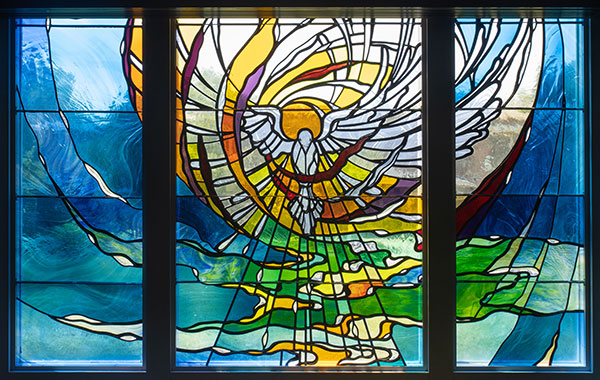 These windows depict the praise of God by His people on earth. The story begins at Creation, depicted in the windows that start in the narthex on the south side of the chapel. The Spirit hovers over the waters of Creation in the form of a dove. The light in these windows captures the Seminary’s motto “Light From Above.”
These windows depict the praise of God by His people on earth. The story begins at Creation, depicted in the windows that start in the narthex on the south side of the chapel. The Spirit hovers over the waters of Creation in the form of a dove. The light in these windows captures the Seminary’s motto “Light From Above.”
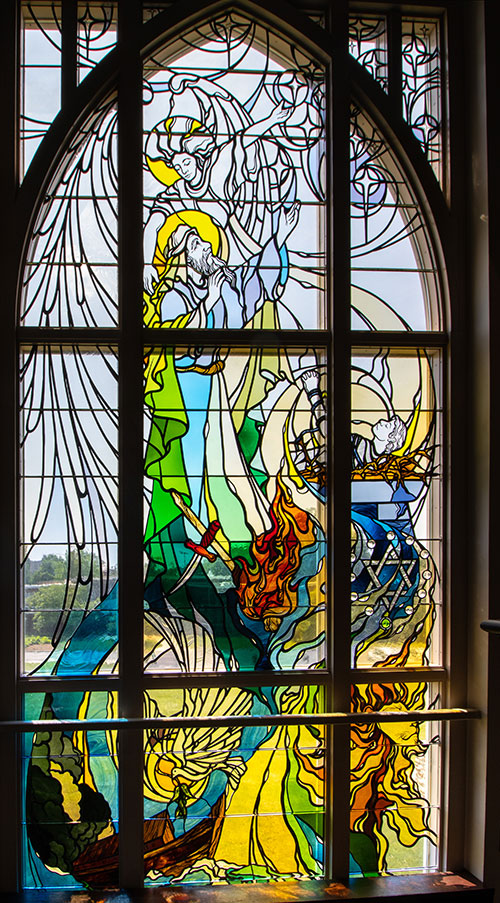 The rest of the windows can be seen from the balcony on the second floor of the chapel. From the second floor, the story continues as Noah’s Ark emerges from a storm. The dove approaching the Ark represents God’s reconciliation with man. Above the Ark is a depiction of Abraham at the moment God stops him from sacrificing his son, Isaac, and instead gives him the promise that his descendants will be as numerous as the stars in the sky.
The rest of the windows can be seen from the balcony on the second floor of the chapel. From the second floor, the story continues as Noah’s Ark emerges from a storm. The dove approaching the Ark represents God’s reconciliation with man. Above the Ark is a depiction of Abraham at the moment God stops him from sacrificing his son, Isaac, and instead gives him the promise that his descendants will be as numerous as the stars in the sky.
The stained glass captures this with 12 stars encircling the Star of David. The 12th star is different. Colored green instead of clear, it represents the tribe of Judah. The Lion of Judah points to the line of David.
-
Middle south nave
Exodus and Kings
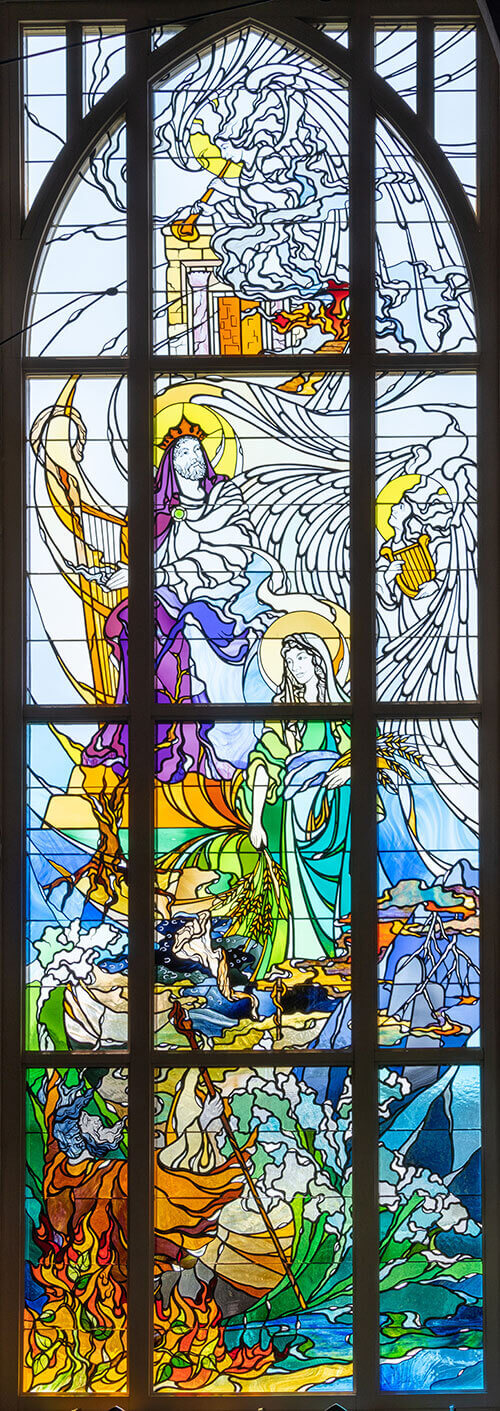 The story continues at the bottom of the next windows with the call of Moses, the burning bush and Moses parting the Red Sea. The stone tablets of the Law are depicted at Mount Sinai. The storm cloud and lightning symbolize God’s anger at His people for worshiping the golden calf.
The story continues at the bottom of the next windows with the call of Moses, the burning bush and Moses parting the Red Sea. The stone tablets of the Law are depicted at Mount Sinai. The storm cloud and lightning symbolize God’s anger at His people for worshiping the golden calf. The desert represents the 40 years of wandering in the wilderness. However, the ram’s horn points to the Promised Land, and the scene brightens as God’s plan of salvation continues through Ruth, who is seen gleaning in the wheat fields. She looks up to her great-grandson, King David. Beneath Ruth, a bronze serpent on the cross is shown, highlighting the Gospel and echoing the serpentine cross that hangs above the altar.
David’s robes turn from blue to purple, and his staff turns to a harp to show his rise from a humble shepherd to the leader of God’s people in Israel and Judah. The stump of Jesse recalls God’s promise of deliverance, and a branch from the stump leads through David. David looks up and sees the temple, which his son, Solomon, will build. Above, angels play instruments of praise, which is a theme throughout the windows.
-
Third south nave
Prophets and Nativity
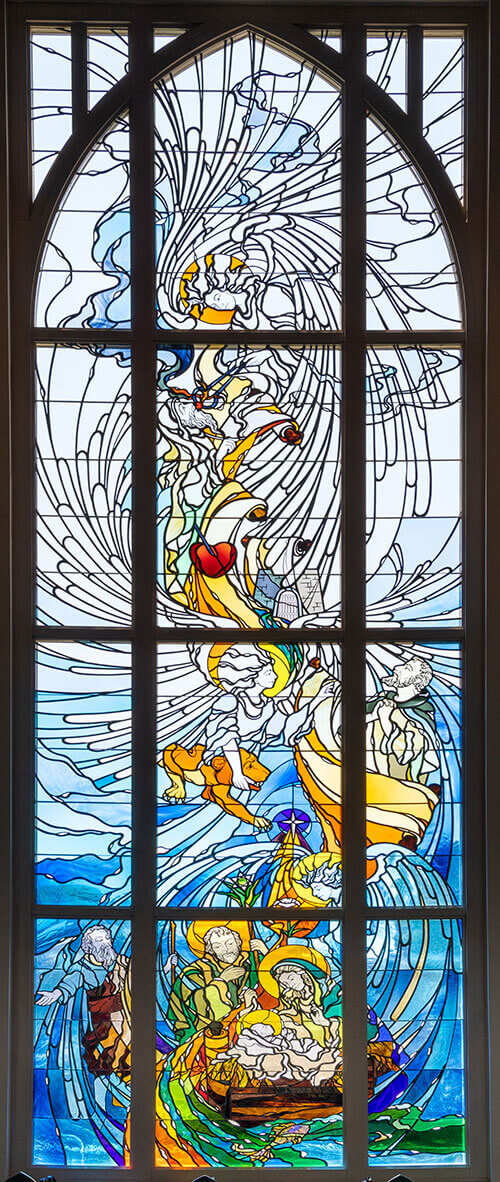 In the next windows the story continues with the ministry of the prophets who point to Christ. Isaiah is depicted near the top of the windows as an angel purifies his lips with a coal from the altar of the Lord. Having been cleansed, Isaiah then writes upon a scroll and tells of the coming Savior.
In the next windows the story continues with the ministry of the prophets who point to Christ. Isaiah is depicted near the top of the windows as an angel purifies his lips with a coal from the altar of the Lord. Having been cleansed, Isaiah then writes upon a scroll and tells of the coming Savior. A second scroll, featuring a human heart and an iron pen, symbolizes Jeremiah. The third scroll depicts Ezekiel’s vision of the temple with the River of Life flowing from it. This vision is fulfilled in the north transept windows, which depict the Exaltation and show water flowing from the temple, descending from the heavens. The fourth scroll belongs to Daniel, who is seen praying as an angel shuts the mouth of a lion in the lion’s den.
Below is the manger of Jesus, where the scroll of Isaiah again appears to the left. The angel above Mary holds a lily in recognition of Mary’s acceptance of God’s plan. Joseph’s staff flowers into the Star of David with an emerald, showing the completion of the lineage from Abraham through David to Christ.
The prophet in the bottom left is Elijah, who gestures toward the north nave windows, which depict the apostles and martyrs, on the other side of chapel. The river flows from the temple and the scroll ends in the manger as the Word that was prophesied becomes flesh.
-
South transept
Crucifixion
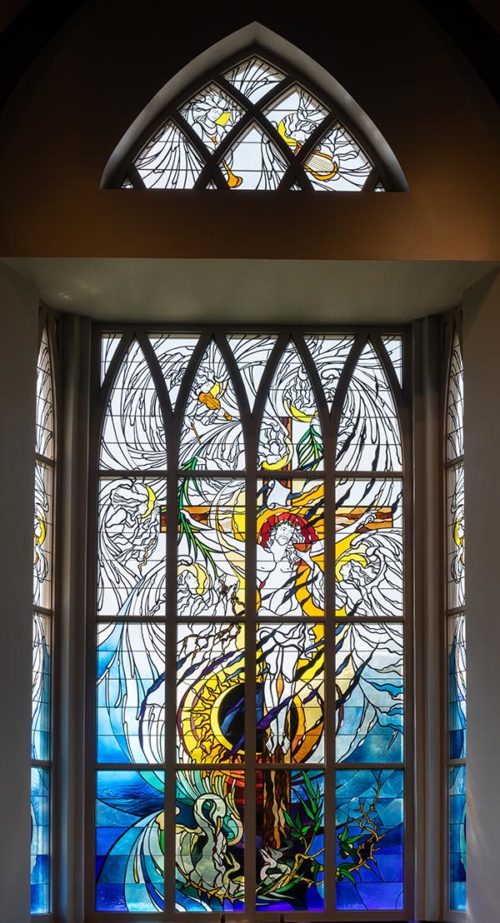 The chancel and transept windows form a triptych, or a three-part image with a common theme. In the south transept windows, the central image shows Jesus on the cross, crucified to bear God’s wrath and to bring forgiveness, life and salvation. Some angels hold palm branches, while others hold the grapes of wrath, which have now withered, because Jesus drinks from the cup of wrath that an angel holds up to His lips.
The chancel and transept windows form a triptych, or a three-part image with a common theme. In the south transept windows, the central image shows Jesus on the cross, crucified to bear God’s wrath and to bring forgiveness, life and salvation. Some angels hold palm branches, while others hold the grapes of wrath, which have now withered, because Jesus drinks from the cup of wrath that an angel holds up to His lips. The eclipse marks the moment of Christ’s death. The shards of darkness represent the sharpness of death. This is seen in the mirror image in the north transept Exaltation windows where those who are damned are bound in the sharpness of death. At the bottom of the stained glass windows is a pelican, an ancient symbol of the Eucharist. The pelican has pierced her breast to feed her young — and they also are fed by the blood of Christ. The pelican’s nest is made of thorns, but also olive branches, showing that Christ’s suffering and death reconcile believers to God.
Some angels still have their instruments of praise, but they refrain from playing them as Christ hangs on the cross. The cross is not the end of the story, as Jesus looks forward to the next windows depicting the Resurrection.
-
Chancel
Resurrection
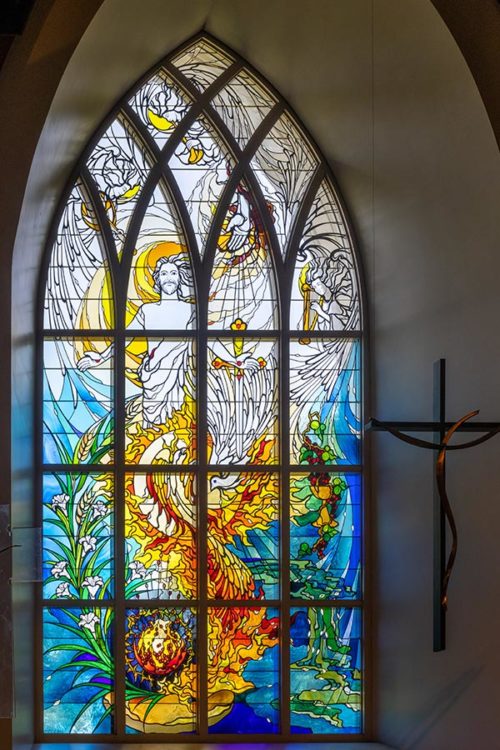 The central windows are the chancel windows at the front of the Chapel of St. Timothy and St. Titus. In these windows, worshipers see the Father, Son and Holy Spirit, and Word and Sacrament. The resurrected Christ rises above the altar, with His wounds still visible in His hands and side. Below Jesus, the darkness of the tomb turns to light.
The central windows are the chancel windows at the front of the Chapel of St. Timothy and St. Titus. In these windows, worshipers see the Father, Son and Holy Spirit, and Word and Sacrament. The resurrected Christ rises above the altar, with His wounds still visible in His hands and side. Below Jesus, the darkness of the tomb turns to light. The pomegranate, an ancient symbol of the Resurrection, bursts outward from the tomb. The crown of thorns encircles this image, but the deadness of these thorns turns to green, new life.
Nearby is an Easter lily. The phoenix, an ancient symbol of rebirth, rises from the bottom and greets the Holy Spirit, depicted as a dove. The Spirit’s descent amid the fire serves as a reminder of Pentecost.
Above, the Father’s hand reaches down from heaven to present His Son. The sword at Jesus’ hand is the Word of God, and the jewels on the cross-shaped sword represent the five wounds of Christ. To the left of Jesus, among the lilies, is wheat for bread, and to the right is the cup with grapes — a reminder of the Lord’s Supper, where Christ’s body and blood are present in the bread and wine. The river is a baptismal stream that flows into the other windows, reminding worshipers of their baptismal identity in Christ. Once again, the angels play their instruments of praise.
-
North transept
Exaltation
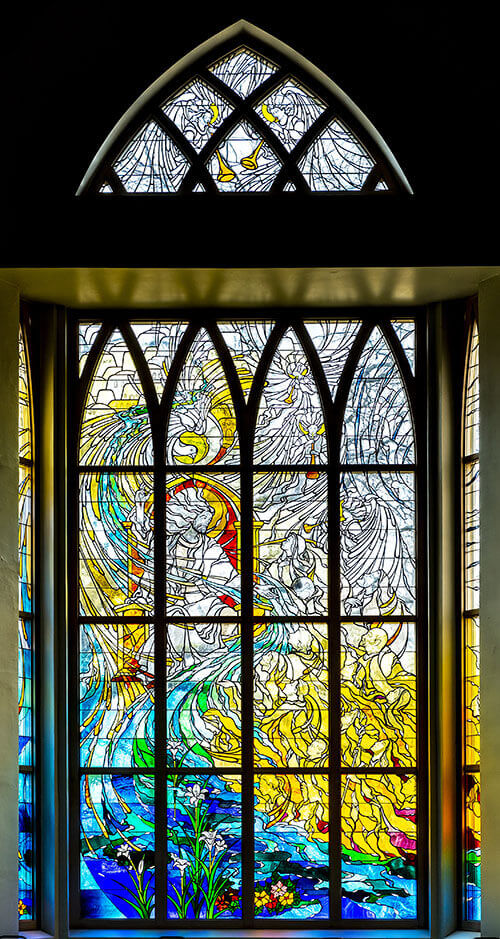 The north transept windows complete the triptych and show how the story ends: with Jesus on the throne, surrounded by angels and faithful worshipers, as He extends a hand to welcome the faithful into the New Jerusalem, which is depicted in the top left of these windows. This fulfills Ezekiel’s prophecy.
The north transept windows complete the triptych and show how the story ends: with Jesus on the throne, surrounded by angels and faithful worshipers, as He extends a hand to welcome the faithful into the New Jerusalem, which is depicted in the top left of these windows. This fulfills Ezekiel’s prophecy. The faithful come from all nations. Some are shown with clear features, while others are not — representing past, present and future believers in Christ. The angels play their trumpets to signal Jesus’ return. The flowers at the bottom of the stained glass represent the New Creation. The River of Life starts at the top of the image, flows around the throne of Christ and joins the waters that flow from window to window.
In the far upper right of the image, human figures appear in distress as they face Christ’s judgment. They are blocked from the New Jerusalem by shards of darkness, similar to those seen with the cross of Christ in the south transept windows.
-
First north narthex/balcony
Waters of New Creation
Just as the south windows trace the praise of God through the history of His people leading up to the birth of Christ, so too the north windows trace the praise of God through the history of His people after the death and resurrection of Christ.
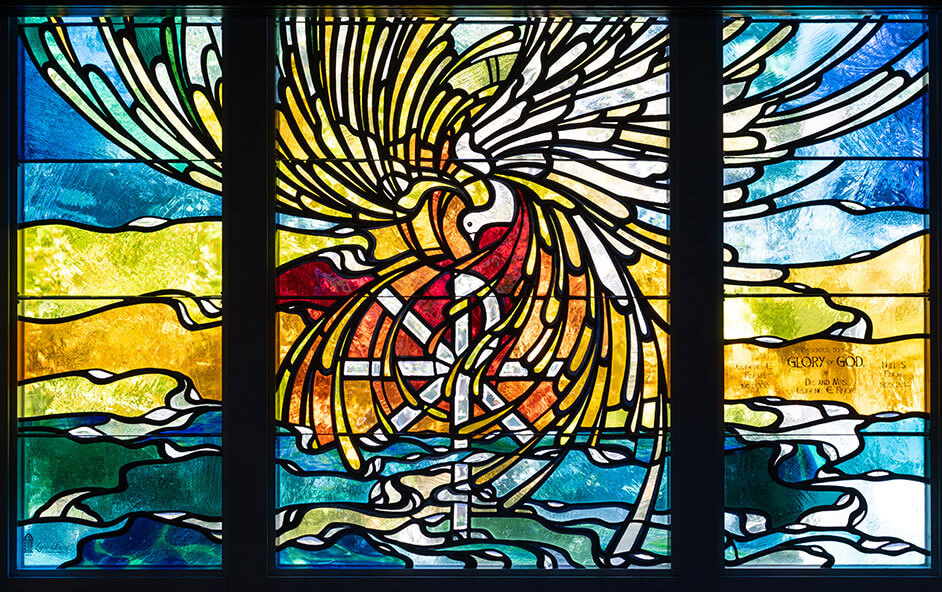 The story begins for Christians at the baptismal font, where they are buried with Christ in Baptism and raised to newness of life. Mirroring the waters of Creation in the south narthex windows, the Spirit hovers over the baptismal waters of the New Creation, centered in Christ, figured by the Chi Rho (the first Greek letters of the title Christ) superimposed on a cross. Here, joined to the death and resurrection of Christ, God’s people have new life.
The story begins for Christians at the baptismal font, where they are buried with Christ in Baptism and raised to newness of life. Mirroring the waters of Creation in the south narthex windows, the Spirit hovers over the baptismal waters of the New Creation, centered in Christ, figured by the Chi Rho (the first Greek letters of the title Christ) superimposed on a cross. Here, joined to the death and resurrection of Christ, God’s people have new life.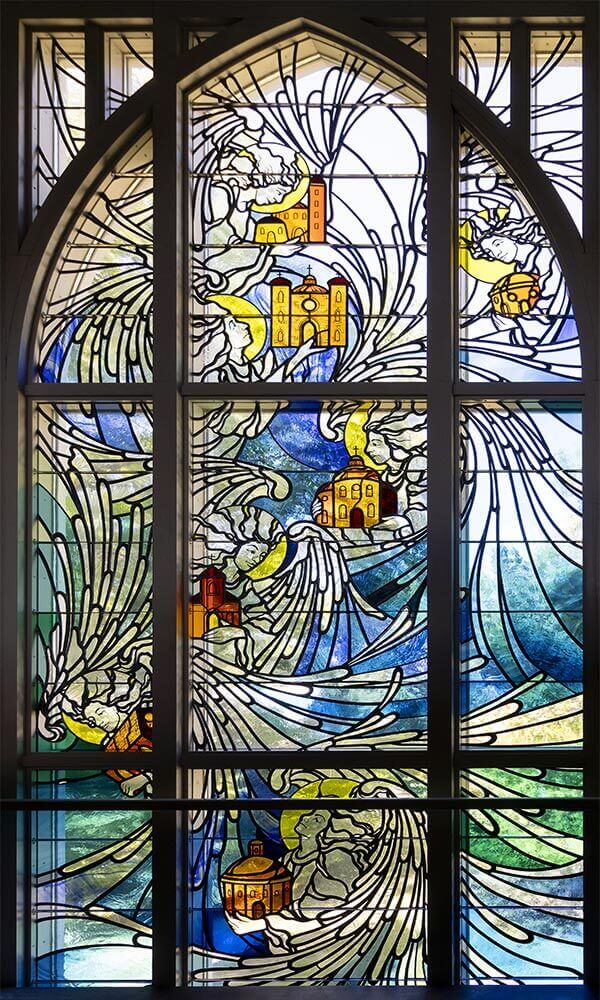 The rest of the windows can be seen from the balcony on the second floor of the chapel. As Abraham was given a vision of his descendants as numerous as the stars, John is given a vision of the seven angels and the seven churches. While their number of seven represents wholeness, each church is architecturally distinct. This vision captures the unity in diversity among God’s people throughout the world as John sees how God’s promise that Abraham would be a blessing for all nations is fulfilled in Christ.
The rest of the windows can be seen from the balcony on the second floor of the chapel. As Abraham was given a vision of his descendants as numerous as the stars, John is given a vision of the seven angels and the seven churches. While their number of seven represents wholeness, each church is architecturally distinct. This vision captures the unity in diversity among God’s people throughout the world as John sees how God’s promise that Abraham would be a blessing for all nations is fulfilled in Christ. -
Middle north nave
Apostles and Martyrs
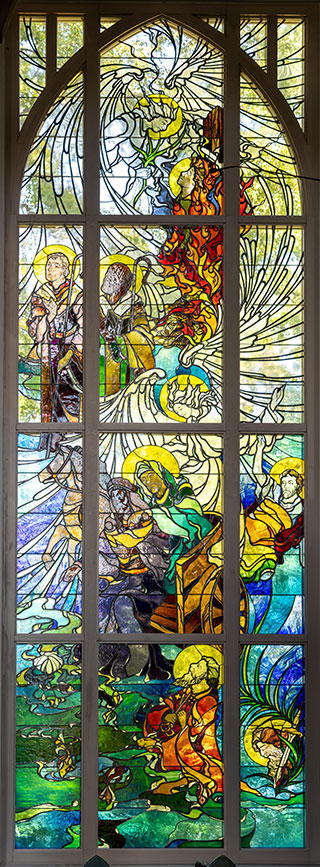 The story continues in these windows with the apostles and martyrs whose lives give praise to God. At the bottom of the windows, the martyrdom of John the Baptist and the confession of St. Peter, to whom Jesus has given the keys of the kingdom to the church, are depicted.
The story continues in these windows with the apostles and martyrs whose lives give praise to God. At the bottom of the windows, the martyrdom of John the Baptist and the confession of St. Peter, to whom Jesus has given the keys of the kingdom to the church, are depicted.The waters of the New Creation are prominent as the Ethiopian eunuch asks to be baptized by Philip. Here, the scroll of Isaiah mirrors the third south nave windows and links the Ethiopian’s Baptism to God’s suffering servant, Jesus Christ. The apostle Paul falls back as he is blinded on the road, while Timothy and Titus look forward to the return of Christ. The figures of Timothy and Titus mirror the original stained glass windows in the chancel and remind worshipers of the namesakes of the chapel and the mission and ministry of Concordia Seminary.
At the top, the fires of martyrdom burn brightly. An angel provides a palm branch to an unnamed martyr, symbolizing assurance of the victory of God over death even as His people continue to pray for those who are persecuted for the faith today.
-
Third north nave
Feast of All Nations
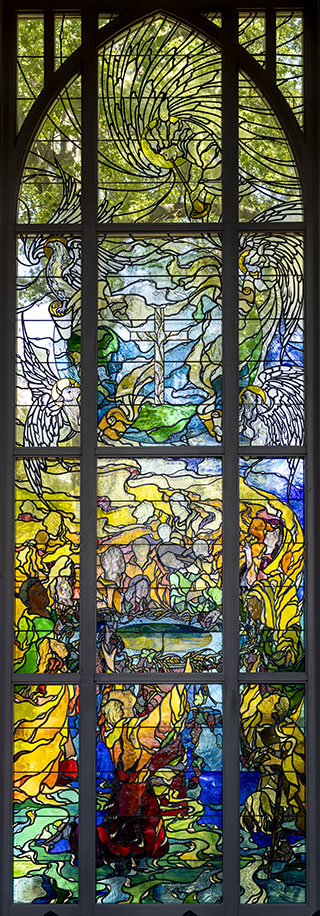 The Feast of All Nations windows foretell of the communion of Christ and His church now and in the life to come.
The Feast of All Nations windows foretell of the communion of Christ and His church now and in the life to come. At the bottom, the Tree of Life emerges from the baptismal waters. The tree, hearkening back to the stump of Jesse, brings forth wheat and grapes. It forms the eucharistic table where disciples from all nations gather. No barrier of language, age, status or physical ability prevents the faithful from communing with Jesus in this world or the world to come.
Above the table, the four evangelists, (Matthew the angel, Mark the lion, Luke the ox and John the eagle) bring the proclamation of the Gospel to the ends of the earth. In the center of the earth stands a transparent cross. Tree-like in look, the cross reveals the living grace of God and reminds the faithful of the presence of Christ in the world, yesterday, today and tomorrow.
The River of Life continues to flow through these windows, calling God’s people to celebrate now in hope of the New Creation. Such anticipation is seen in the eagle who looks toward the return of Christ and the figures whose robes begin to change to jewel-like tones. Indeed, all who gather around the eucharistic table participate in a foretaste of the feast to come.
Videos
Virtual Tour of the Chapel Stained Glass Windows
Dr. David Schmitt, the Gregg H. Benidt Memorial Professor of Homiletics and Literature at Concordia Seminary, St. Louis, gives a virtual tour of the stained glass windows in the Chapel of St. Timothy and St. Titus. The windows were installed starting in 2020 thanks to a generous gift from the Eugene E. and Nell S. Fincke Memorial Trust.
Panoramic video of chapel stained glass windows
Enjoy this panoramic video showing the stained glass windows in the Chapel of St. Timothy and St. Titus, which is located on the campus of Concordia Seminary, St. Louis. Thanks to a generous gift from the Eugene E. and Nell S. Fincke Memorial Trust, stained glass windows are being installed throughout the entirety of the chapel — chancel, transept, nave and narthex. This video shows the chancel window, and north and south transept windows.
Time Lapse – Installation of new stained glass
A time lapse of the installation of the Chancel window in the Chapel of St. Timothy and St. Titus.
Time Lapse – Removal of original stained glass
A time lapse of the removal of the stained glass from the Chapel of St. Timothy and St. Titus in preparation of new stained glass windows.